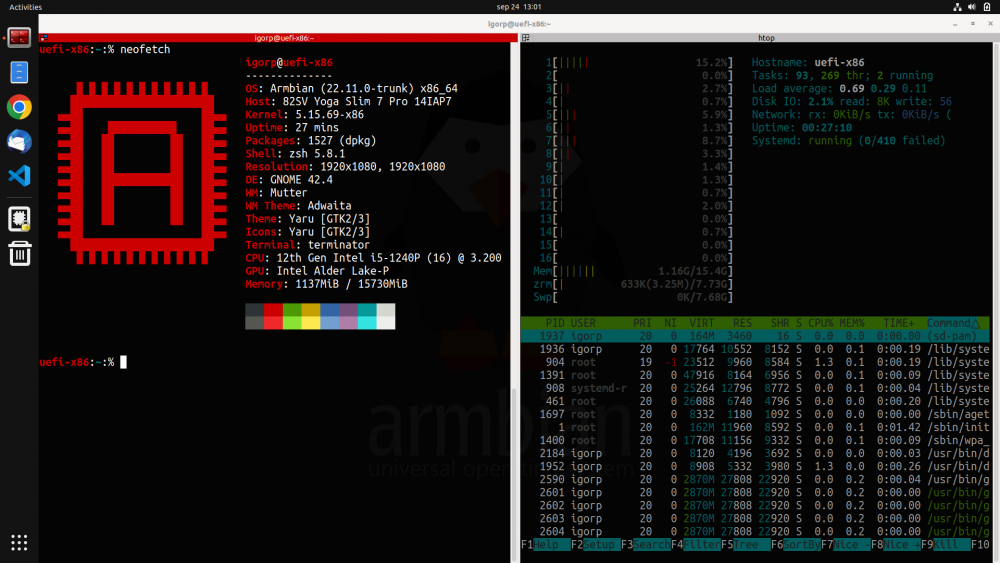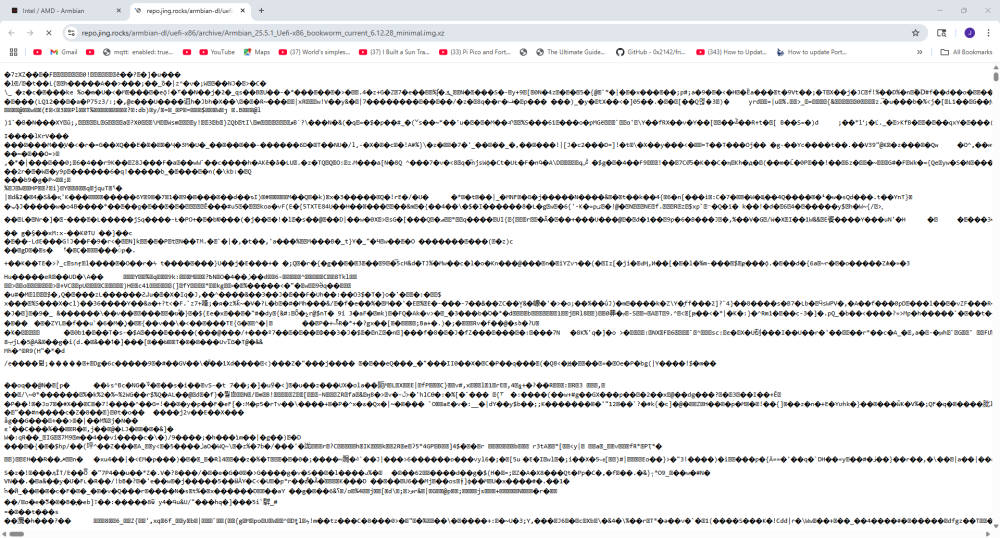Search the Community
Showing results for tags 'uefi-x86'.
-
Hi I have upgraded an existing x86 Armbian system with kernel 6.6.63 and zfs 2.3.2 to the suggested kernel 6.12.32-current-x86, but I cannot get the zfs kernel module loaded after the latest updates to Armbian 25.5.1 noble. I also tried on other kernels, only the old 6.6.63 seems to work. Normally when you select a different kernel in the armbian-config menu, it should automatically compile the zfs modules if it is activated. It just skips it. But you can of course compile it with the provided DKMS system: the build just finishes fine, without any error, also the install, but when you try to load the module: it responds with: dmesg: I have zfs 2.3.2 on kernel 6.12.32-current-bcm2711 running just fine on a Raspberry Pi 4, so I tested what would happen if I just build a small kernel driver module: root@armbian:/usr/src/dummydriver# cat dummydriver.c root@armbian:/usr/src/dummydriver# cat Makefile So when I run this on the Raspberry Pi 4, I can load the module and unload But when I run this on the x86 machine I get the same error: root@armbian:/usr/src/dummydriver# modinfo dummydriver.ko root@armbian:/usr/src/dummydriver# gcc --version I also tried gcc 11.4.0 Here is my armbianmonitor -u: https://paste.armbian.com/orepumazam Any help welcome! Philippe
-
hi, i try to install the current IOT/minmal image on the intern ssd on a old thinclient. USB-Drive will ident as sda and the ssd as sdb. if i use on armbian-config the install script for install, he create two partitions (sdb1 &2 / efi & linux) but it only boot with usb drive. On the usb drive i has a BIOS boot partition, must i swaphis somehow to the ssd drive?
-
So I recently loaded the x86 Armbian 6.12 - Ubuntu 24.04 (Noble) server image onto a GEEKOM Air12 Lite N150 (wow that was a mouthful), only to find the ethernet port missing... turns out the Motorcomm YT6801 Ethernet Controller it uses is not in the mainline distro and has to be built manually. I have so far referenced the following resources about this: https://github.com/albertogviana/YT6801 https://github.com/dante1613/Motorcomm-YT6801 https://forums.linuxmint.com/viewtopic.php?t=438301 https://deb.tuxedocomputers.com/ubuntu/pool/main/t/tuxedo-yt6801/ and run the gamut for two days straight without much luck. First the linux headers were not installed, so I installed them through armbian-config, only to find out they were still not available because potentially the headers are for 6.12.41 are not available? https://mirror.twds.com.tw/armbian-apt/pool/main/l/linux-headers-current-x86/ (I don't see them listed here, I do see a 6.12.32 and a 6.12.44) Then I rolled back the Kernel to 6.12.32 and tried to install the headers again them through armbian-config, only to find out they were still not available?!?!? So I installed them by downloading the *.deb directly and manually installed them. Now I can get the latest tuxedo driver (tuxedo-yt6801_1.0.30tux4_all.deb) to build and install, but the module will not load. journalctl | grep "yt6801" shows .gnu.linkonce.this_module section size must match the kernel's built struct module size at run time here is the output from the install: root@Armbian:~# sudo dpkg -i tuxedo-yt6801_1.0.30tux4_all.deb (Reading database ... 79866 files and directories currently installed.) Preparing to unpack tuxedo-yt6801_1.0.30tux4_all.deb ... Module tuxedo-yt6801-1.0.30tux4 for kernel 6.12.32-current-x86 (x86_64). Before uninstall, this module version was ACTIVE on this kernel. yt6801.ko: - Uninstallation - Deleting from: /lib/modules/6.12.32-current-x86/updates/dkms/ - Original module - No original module was found for this module on this kernel. - Use the dkms install command to reinstall any previous module version. depmod......... Deleting module tuxedo-yt6801-1.0.30tux4 completely from the DKMS tree. (Re)load module if possible Unpacking tuxedo-yt6801 (1.0.30tux4) over (1.0.30tux4) ... Setting up tuxedo-yt6801 (1.0.30tux4) ... Loading new tuxedo-yt6801-1.0.30tux4 DKMS files... Building for 6.12.32-current-x86 Building initial module for 6.12.32-current-x86 Done. yt6801.ko: Running module version sanity check. - Original module - No original module exists within this kernel - Installation - Installing to /lib/modules/6.12.32-current-x86/updates/dkms/ depmod... (Re)load module if possible Warning: Could not load module yt6801. Any clues on what I might be missing? I'm not a hardcore Linux pro by any means, but I'm not a novice either. Any help would be much appreciated.
-
Many of us are using Armbian not just on ARM single board computers but also on servers (bare metal & virtual). We use our builds since we trust it more then Debian, Ubuntu, not to mention other distributions that are recklessly updating and one ends up as an OS tester and not OS user. Personally I use Armbian Jammy on Ryzen 9 workstation with great success. My primary use case is development / productivity. For the road I used to have 13" Dell notebook which recently suddenly died. It was out of warranty so I had to get something new. After some testings of various devices I settled with 12th Gen Intel i5-1240P powered Lenovo. Then I tried many general purpose distros to see how well they work and all had some (minor) troubles ... We are having UEFI images (common image) since some time, but UEFI nor desktops were fine tuned nor ready for such performance daily driver desktop usage. We were close, but not close enough to just run it. Past two weeks we have been lifting general UEFI support, fixed many bugs and what came out is "Armbian ultimate developers desktop build". - improved support in GRUB (armbian wallpaper) & HiDPI GRUB support - all preinstalled applications are normal apt packages - current 5.15.y kernel, Jammy userland (5.19.y has some strange issues) - snapd is not installed (user can install it) - HiDPI support (automated adjustments on big screen resolutions) - NVIDIA graphics acceleration with proprietary driver (x86 only) - Intel graphics acceleration also works out of the box - preinstalled Google Chrome (x86 only) - preinstalled Microsoft Visual Studio Code (x86 only) - ZFS 2.1.5 ready (apt install zfsutils-linux zfs-dkms) - face unlock works perfectly fine on this laptop - installation to SSD drive to dual boot with Windows 10/11 is supported Armbian classical way by transferring actual live image to the prepared partition via nand-sata-install. All you need to do is prepare spare space on your drive, Windows 10/11 or Linux, UEFI support (most if not all hardware for past 10 years has it). I have tweaked images (XFCE, Gnome, Cinnamon) a bit to my personal needs, but making changes is welcome. Nice to have: disk encryption within nand-sata-install, small bug fixing, additional DEs. Currently we have CLI, XFCE, Gnome and Cinnamon. Others are too buggy. https://www.armbian.com/uefi-x86/ https://www.armbian.com/uefi-arm64/ Please report where it works and how (well)!
-
hi all, I was looking for some unified os for more "rpi zero" clones and found beautiful armbian; and I am quite new to linux still, longtime/decades windows user; to "dogfood", I am also considering use of armbian on my "tiny-big" uefi-x86 (now NUC10, but got now new amd ryzen7 8845hs gmktec nucbox k8 plus), so I tried as very first setup on that ryzen7 latest armbian "ubuntu gnome" - monitor output is attached, so far so good, although I dont know if everything around usb3/4 is working well (log contains some red messages, dont understand them) - it was only simple install, and I have this comments: https://www.gmktec.com/products/amd-ryzen-7-8845hs-mini-pc-nucbox-k8-plus usb-live boot was okay, I then executed armbian-config where in "storage" I proceeded with default installation (I didnt read well the instructions to run armbian-install in fact, this is not in set of icons after usb-live boot also...), which it seems selected nvme1 instead of nvme0 ??? (will try again with other variants as xfce again), so after this way of installation, reboot was into grub rescue, so I did it again forced to nvme0 (deleting all from nvme1 also by gparted) and the reboot was okay ... although, when I am powering-off linux from menu then nucbox pwr button green led switches off, BUT after removing usb and swiching on the nucbox by button nothing happens, black screen (long time, nothing) - I expected some longer boots because of DDR5 behavior (new to me too) but this is not the case. I must force OFF the nucbox by holding power button for 4secs and then re-powering on is okay ... this is not nice behavior 🙂 this nucbox K8 plus has very open APTIO BIOS, nothing is simplified and I left everything on auto for now, it seems secure boot is disabled and what surprised me too is that install to nvme storage did only MBR partitions, not GPT. hope its all handled well for offsets and blocksizes - are possible (good?) 4KB sectors for most efficient nvme flash ssd? I dont know if some defaults changes in bios can force armbian to defalt to GPT partitions, even if it is necessary. in windows, I have 2 big disks now and data/user are is only selected logically by virtuall drive letters (visualsubst), I use lots of them to separate areas and need this to mimic somehow in linux; its question if separate "user" partition with fixed size is okay too ... on windows, I do backups by onedrive syncing and by ZIPs to second drive and even to usb attached sata disks too and only for "really" user data, not everything the same way - its question if on linux its simpler to backup entire partitions (??) I was also quite surprised that "ubuntu gnome" variant boots only to some "tablet only?? ui" very simple ui without any menu, windows without minimize icons ... I am new to linux, what is this "style"? this is "unity" or some tablet variant selected by sone defaults? ... very weird for me, too simple, not useable as desktop, so I will try XFCE and KDE Neon too, sure ... When I tried to add language for regional date/time formats support , trying to download CZ (Czech) failed, probably some minor quirk too; I had no chance to test everything, but I was surprised that it during boot found the WIFI and installation was really deadly easy and sexy, despite that first default bad selection of nvme1 as target (I am not sure if I didnt it in fact .... will try again similar way) ... but what is shown in icons/apps set is contrary to some getting started doc pages, where is mentioned "armbian-install" (not necessary as armbian-config - storage did it too??), btw red config and configng icons launch the same script; I understand that this is lightweight setup and I in fact like it a lot, but that simplistic (tablet?) desktop was like something for kids )) so, thanks to all NicoD videos (I saw tens of them) as my primary intention to test faster "rpi zero" clones is to run some Sinclair QL emulator on them, something with SMSQE, ideally, somehow, there are variants of it; on windows, best/fastest is probably QPC2/SMSQE but this is not full emulation, its hybrid where interfacing to fast windows host is often accelerated on it, so this is not linux-aware emulator, and I cant imagine if it would be possible in wine, probably not; other emulators exists, one of them for SMSQE is based on java too - goal was simply to make some low-power portable Sinclair QL (with SMSQE) machine, so I need to select best/fastest "rpi zero" clone with working GPU acceleration for sure. https://www.kilgus.net/qpc/what/ youtube: yU0ptNyNqcI It is not yet clear if I will converty my main big machine to linux, but having one unified system for "everyhting arm" is definitely nice, it seems that armbian can be my primary linux distro even in virtual machines, I like the concept and systematic approach in documentation and development and even contribution, I read lot of docs and its very nice, it seems. So will be glad also to support you, as much as possible. Thanks, Petr
-
I would like to run Armbian on my multi boot PC. i came across a video on how to install Armbian on an X86 PC. How you have to use Gnome Disk to Restore Image to your drive. Does anybody know if it would work correctly doing that on a multi boot PC? I know I would need to update Grub afterwards for it to show in the list.
-
Hello, I am trying to install Armbian UEFI-x86 into this very small mini PC, but with secure boot enabled it only shows this screen: Disabling the secure boot isn't an option, because every time I turn it off and then turn it on the next morning, the BIOS settings are being reset, then the secure boot is enabled once again (I believe it is intentional, because the CMOS battery only keeps the clock & date). Moreover, I want to use it as a headless computer, so no keyboard will be attached. Is this fixable or Armbian isn't compatible with secure boot? Thanks in advance.
-
Hi, I'm running Armbian UEFI x86 on a Radxa Rock X4 and I'm struggling to find, where to put the kernel parameters. The armbian-config SY003 suggests /boot/armbianEnv.txt. So I've put a line with extraargs=, but it is ignored. Then I've tried /etc/default/grub adding the parameters to GRUB_CMDLINE_LINUX_DEFAULT= and then doing update-grub, but it is also ignored. Where should I put the kernel parameters?
-
I've got an NVME SSD formated to 4Kn block size which means `dd`ing the .img file to the drive isn't going to work. Is there a recommended way to install Armbian in this situation?
-
Hello @Igor I have installed Armbian 24.2.4 Jammy Kde-neon Kernel: 6.6.21, Size: 1.9GB, Release date: Mar 12, 2024 on a mini pc J4125 Celeron based. What I noticed that is during initial boot, when finds the timezone and asks to accept or select a diff one, i tried 2 times. I selected accept and then took minuted to complete and enter the desktop First time I killed it and second clean i waited.:-) I checked in armbian-config the locales and noticed that ALL options were checked. Which makes sense why I waited so long If this a know bug or needs to be fixed? Just wanted to bring to your attention. Rest work smooth and fast! Tx for your work
-
I have tried all known possible combos to hide the grub menu on boot but no luck I tested on the /etc/default/grub and /etc/default/grub.d/98-armbian.cfg Is there another config file Im missing that ignores above, especially later? Tried also with custom override config at boot. Any advise is welcome
-
Hi community, Context I build my own custom Arabian image on arm 32bit (prod), and experimenting running the following armbian image configuration on Qemu with console/serial only support for uefi-x86 and uefi-arm64 boards to speed up development/test. Problem I stumble upon something odd: both "uefi-*" boards are configured to only run GRUB in gfxterm mode ONLY. BOARD: uefi-86 -> BOARDFAMILY="uefi-x86". -> UEFI_GRUB_TERMINAL="gfxterm" [0] BOARD: uefi-arm64 -> BOARDFAMILY="uefi-arm64". -> UEFI_GRUB_TERMINAL="gfxterm" [1] [0] https://github.com/armbian/build/blob/2afd8fe9bb8aca33a2a3913e931fc43c43c8e309/config/sources/families/uefi-x86.conf#L11 [1] https://github.com/armbian/build/blob/2afd8fe9bb8aca33a2a3913e931fc43c43c8e309/config/sources/families/uefi-arm64.conf#L10 Image built from these boards should be runnable as CLI image (no gui) or Desktop image (gui). However, when running with qemu -nographic ... these image can't boot up to a working shell and produce an error: "GRUB: gfxterm is not supported" Proposed change I would like to submit a patch to change UEFI_GRUB_TERMINAL to "gfxterm vga_text console serial" to cover a large set of virtualised hardware configurations. 1. Is this something you guys are interested in ? 2. Does this fix need more than the proposed change to achieve the desired objective ? Thanks
-
Hello, Is anybody able to install and install Armbian bookworm on Proxmox (OVMF uefi, Q35)? I tried multiple times but proxmox doesn't recognize the UEFI partition and I can only boot from the USB... Debian boots fine tho.
-
Hello, I wanna test Armbian x86 on virtual machine. Is possible to convert its img file to some format (vdi or vmdk) and boot on Virtualbox? I made a attempt but it wont boot.. VBoxManage.exe convertfromraw --format VDI armbian.img ambian.vdi Thx a lot
-
I was curious if anyone has experience with using Armbian on older x86 server hardware systems. This would be for a home-lab sort of setup. In the past, I fought with Ubuntu Server and found that I missed the Armbian-Config utility that made setup a breeze. (Specifically looking at WIWYNN LYRA-M SV315, INTEL XEON E5-2670 V2 SR1A7 2.5GHZ 10-C0RE) I am planning to run a MariaDB instance for a scientific database. My past test use was using Armbian on an 8 GB Raspberry pi 4B, with MariaDB, and it worked very well, until the SD card failed. Any thoughts or points of caution before attempting this would be appreciated. I have generally had a very positive experience with Armbian so far.









